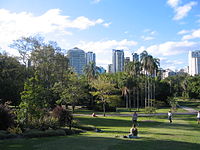- City Botanic Gardens
-
City Botanic Gardens
From the botanical garden facing Alice StreetType Botanical Location Brisbane, Queensland 27°28′29″S 153°01′48″E / 27.4747°S 153.0301°ECoordinates: 27°28′29″S 153°01′48″E / 27.4747°S 153.0301°E Size 20 hectares (49 acres) Opened 1855 Owned by Brisbane City Council The City Botanic Gardens (formerly the Brisbane Botanic Gardens) is located on a point known as Gardens Point on the Brisbane River adjacent to the central business district of the city of Brisbane. The gardens area has frontages on both Alice Street and George Street.
The roughly triangular park is bordered by the Brisbane River on one side, and the grounds of Parliament House and the Queensland University of Technology's Gardens Point campus on another. The Alice Street frontage stretches from George Street (immediately opposite to Queensland Parliament House) to Edward Street at the Brisbane River.
The Gardens include Brisbane's most mature gardens, with many rare and unusual botanic species. In particular the Gardens feature a special collection of cycads, palms, figs and bamboo.
The Queensland Government Heritage Register describes the Gardens as "[T]he most significant, non-Aboriginal cultural landscape in Queensland, having a continuous horticultural history since 1828, without any significant loss of land area or change in use over that time. It remains the premier public park and recreational facility for the capital of Queensland, which role it has performed since the early 1840s."[1]
Contents
History
The site was selected as a public garden in 1828 by the NSW Colonial Botanist Charles Fraser,[2] three years after the establishment of the European settlement at nearby North Quay, Brisbane. In 1855, a portion of the land was declared a 'Botanic Reserve' and Walter Hill was appointed as curator, a position he held until 1881.[3][1] Some of the older trees planted in the Gardens were the first of their species to be planted in Australia, due to Hill's experiments to acclimatise plants.[2] The experiments served practical outcomes. Plants with potential commercial value were tested in the gardens, first to see if they were viable, to determine what they needed for growth and if a profit could be made.[4]
The extant City Botanic Gardens was formed by the amalgamation of the original Botanic Gardens with the Domain (the southern side of Gardens Point) and Queen's Park in 1916, bringing its total area to around 20 hectares[3] (Queen's Park comprised a 10 acre (4 ha) strip along Alice Street, which originally served as a park and a sporting field, where regular cricket and football matches were held). The former curator's cottage built for J.F. Bailey, curator from 1905-1917, is now the City Gardens Cafe.[1]
Due to the proximity to the river, the Botanic Gardens have been flooded nine times between 1870-2011. With many plants being washed away, the Brisbane City Council established a new botanic gardens at Mount Coot-tha.
The Gardens were also the home for over 100 years for 'Harriet', a tortoise reportedly collected by Charles Darwin during his visit to the Galápagos Islands in 1835 and donated to the Gardens in 1860 by John Clements Wickham, former commander of the HMS Beagle and later 'Government Resident' for Moreton Bay. Harriet was named in honour of Harry Oakman, curator of the Gardens from 1945 to 1962 and the creator of the (now disbanded) zoo at the Gardens.
Access
The gardens are accessible by Alice Street, the Goodwill Bridge and Brisbane City Council's ferries and CityCats at the Gardens Point and Eagle St wharves. The river frontage features a mangrove boardwalk.
Points of interest
Points of interest in the gardens include:
- the City Gardens Cafe (originally the curator's house)
- the Walter Hill Fountain
- Gardens Cycle Hire station at Albert Street entrance
Functions
As well as being a botanic gardens, the gardens have many other functions. Many office workers from the nearby business district use the gardens for reading and laying on grass in lunchtimes. It is a popular venue for weddings. A wedding can be seen nearly every weekend.
At the rear of the gardens is Brisbane River Stage, in which many council concerts and big band names take place, as well as the annual Lord Mayor's Christmas Carols every Christmas. There are also guided walks, self-guided walks, picnic areas and a restaurant on the grounds of the botanic gardens.
Opening Hours
The gardens are open 24 hours, with pathways lit at night.
See also
References
- ^ a b c "Brisbane Botanic Gardens (entry CHIMS600067)". Queensland Heritage Register. Queensland Environmental Protection Agency. http://www.epa.qld.gov.au/chims/placeDetail.html?siteId=600067.
- ^ a b Gregory, Helen (2007). Brisbane Then and Now. Wingfield, South Australia: Salamander Books. p. 38. ISBN 9781741730111.
- ^ a b Fagg, Murray (26 May 2009). "City Botanic Gardens (Brisbane)". Australian National Botanic Gardens. Council of Heads of Australian Botanic Gardens. http://www.chabg.gov.au/chabg/bg-dir/026.html. Retrieved 2 September 2010.
- ^ Jolly, Paul (1997), "The planning and design of Old Government House", in Shaw, Barry, Brisbane:Corridors of Power, Papers, 15, Brisbane: Brisbane History Group Inc, p. 72, ISBN 0958646910
External links
Brisbane Landmarks Government City Hall • Customs House • Government House • Lands Administration Building • Newstead House • Old Government House • Parliament House • Treasury Building • South Brisbane Town HallArts and Culture Entertainment Squares and Plazas Parkland South Bank Parklands · Roma Street Parkland · Wickham Park · New Farm Park · City Botanic Gardens · Mt Coot-tha Botanic Gardens · Queens Gardens · Brisbane Forest ParkTransport Brisbane Airport · Story Bridge · Goodwill Bridge · Central Station · Clem Jones Tunnel · Gateway BridgeSport Ballymore Stadium · Suncorp Stadium · The Gabba · Queensland Tennis Centre · Queensland Sport and Athletics CentreHeritage St Luke's Anglican Church · St John's Cathedral · St Stephen's Cathedral · All Saints Anglican Church · Anzac Square · Albert Bridge · Howard Smith WharvesCategories:- Botanical gardens in Australia
- Parks in Brisbane
- Visitor attractions in Brisbane
- 1855 establishments in Australia
Wikimedia Foundation. 2010.






